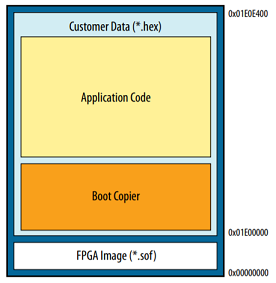Visible to Intel only — GUID: uaa1481325712087
Ixiasoft
Visible to Intel only — GUID: uaa1481325712087
Ixiasoft
5.2.3.4. Nios® II Processor Application Copied from EPCQ Flash to RAM Using Boot Copier
You can use a boot copier to copy the Nios® II application from EPCQ flash to RAM when multiple iterations of application software development and high system performance are required. Intel FPGA recommends this solution for Nios® II processor booting from Serial flash (EPCQ).
The Nios® II SBT tool automatically adds the Nios® II processor memcpy-based boot copier to the system when the executable file (.elf) is converted to the memory initialization file (.hex). The boot copier is located at the base address of the HEX data, followed by the application.
